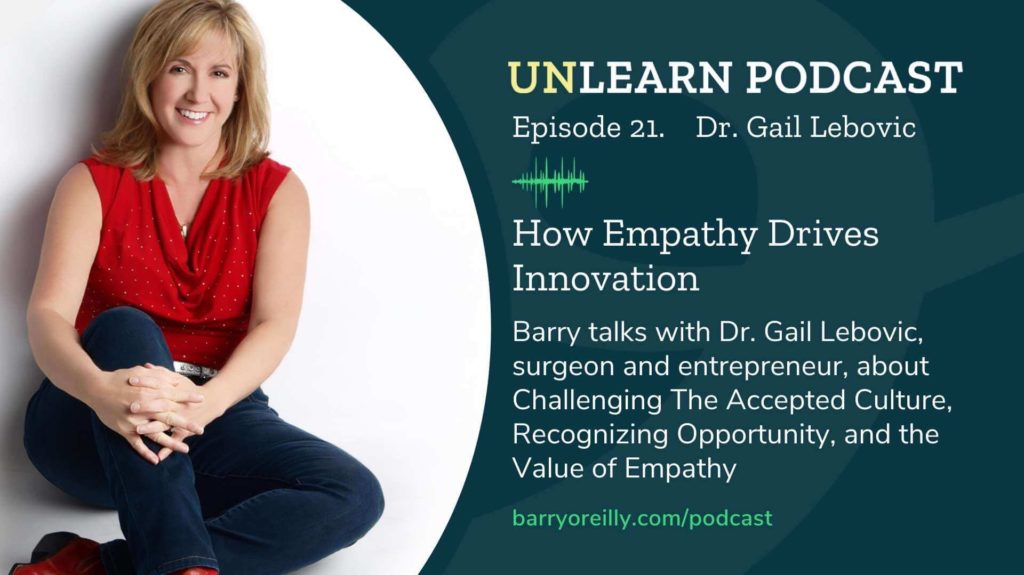Dr. Gail Lebovic is a surgeon and entrepreneur whose work has made a great impact on the healthcare space, particularly by devising innovative surgical techniques and developing medical devices aimed at improving the lives of women with breast cancer. Host Barry O’Reilly describes her as a world leader with a passion for problem-solving and for thinking outside the box, which makes her unique in the highly structured field of surgery. Listen to How Empathy Drives Innovation with Dr. Gail Lebovic.
Challenging The Accepted Culture
Surgical thinking is founded on achieving good outcomes and avoiding risk. Very few surgeons would think about trying a different procedure if the accepted way is working. Gail, however, knew that there had to be a better way to do breast cancer surgery. She felt that when a surgeon performs a mastectomy, he or she should also be doing a reconstruction. This was a radical idea at the time. Eventually, she sought out Dr. Donald Laub as her mentor and together they explored how to make this idea happen. Barry comments that everything pushes against you when you’re trying to innovate, especially in highly regulated, high consequence scenarios. [Listen from 1:25]

Breakthrough
Even with a sought-after practice, and data to support her methods, Dr. Gail still found herself marginalized by the mainstream surgical community. Nevertheless, she focused on helping her patients and became involved in medical technology. She realized that she could impact many more people by creating technology and teaching others how to use it. Her MammoPad invention has now been used by over 100 million women. Another step she took was teaching surgeons her techniques. One surgeon can impact more than 250 cancer patients a year, she points out. To date, she has trained over 1000 surgeons around the world, escalating the opportunity to impact many more women than one on one. She created a post-graduate course that has hosted more than 18 conferences thanks in part to a grant from the Mary Kay foundation. [Listen from 7:40]
Recognizing Opportunity
Barry asks Gail to describe how she recognizes an opportunity, including the steps she takes to determine if it’s worth pursuing. He quips that most Silicon Valley entrepreneurs start with a solution that’s looking for a problem! For Gail, it’s just the opposite – it begins by recognizing a problem or a basic need – for example, how to help more women get life-saving mammograms. Then you have to diligently research many different aspects of the problem as well as the potential solutions you may have. Then you can start prototyping. Ultimately, choosing the right prototype is a complex problem, but in the end you have to rely on gut instinct, she says. “That’s the key moment that ultimately will drive adoption.” [Listen from 13:05]
Critical Thinking Skills
People tend to optimize for the happy path, and very rarely do they think about unintended consequences, Barry comments. He finds that critical thinking is often a missing component in product development. Gail says that successful product development takes a cohesive team. You can’t get married to an idea just because you like it. The objective is to keep critiquing your designs and anticipating the risks until you have a prototype that you feel confident in. Barry adds that leaders should role-model accepting criticism of their own ideas; it’s one of the most powerful things you can do, he says. [Listen from 17:10]
The Value of Empathy
Automating manual processes is great, but technology cannot replace the human touch. The medical process is both an art and a skill, Gail points out. Empathy is what drives the identification of needs, which inspires creation of technology products that save people’s lives and provides an avenue for compassionate care along the way. [Listen from 29:55]
Looking Ahead
Gail is happy that she has been involved in most of the changes in breast cancer care in recent times. Her greatest contribution, though, is training other surgeons to use innovative techniques, many of which she developed and adopted for use in treating breast cancer. She will continue to develop technology because she is “addicted to it,” she says. On the other hand, she is worried about the human factor in medicine – both for patients, who have a harder time interacting with the medical community now; as well as for physicians, who are suffering burnout at an alarming rate. [Listen from 32:55]















